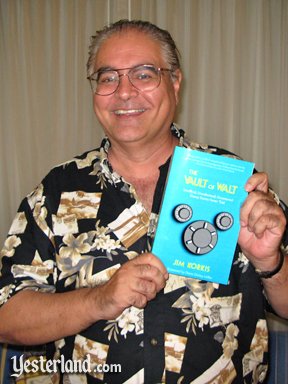
|
The Casablanca Plane Myth: Not a Myth After All? |
||
|
|
|||
|
At one time, the airplane in the Casablanca scene of The Great Movie Ride was said to be the actual plane from the classic 1942 motion picture. But then that claim was busted as “impossible.” Not so fast! It’s not impossible after all. I discussed the reasons with Jim Korkis.
|
|||
|
The Claim: “The airplane in the Casablanca scene of The Great Movie Ride is the actual plane seen during the memorable conclusion of the movie.” Status: Might Be True |
|||
|
The Claim: “It would be impossible for the plane in The Great Movie Ride to be the actual plane from the movie Casablanca because there was no real, full-size plane—only movie props on a soundstage.” Status: False |
|||
|
|
|||
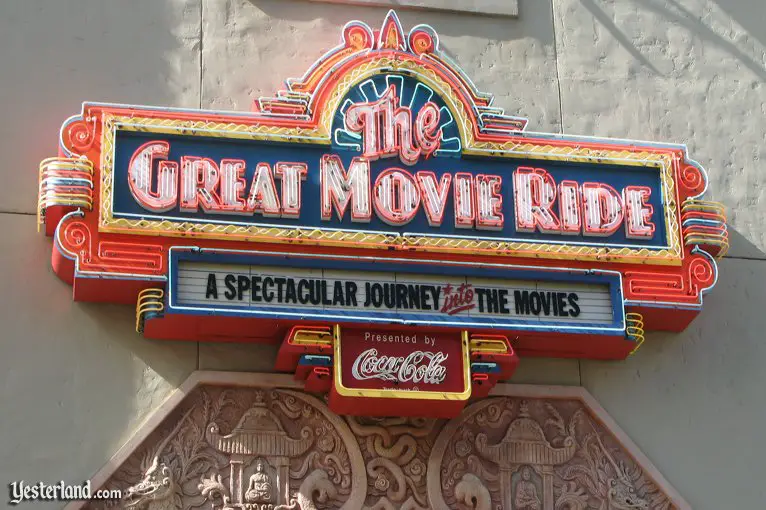
Sign for The Great Movie Ride |
|||
|
When Disney-MGM Studios park was under construction, news emerged that a plane purchased by Disney for use in a ride had an illustrious history. The Chicago Tribune ran a short article, “Casablanca Plane Lands At Disney,” by Desmond Ryan (Knight-Ridder Newspapers), on June 30, 1988: Possibly the most famous farewell scene in all of movies separated Humphrey Bogart and Ingrid Bergman in Casablanca, a moment that meant a great deal to lovers and families parted in World War II. The plane in the scene is a Lockheed Electra 12A and, as time went by, nobody had any idea what happened to it. It has been found and restored to its rightful place in the collective moviegoing memory. Walt Disney Studios was putting together props from significant movies for an attraction called The Great Movie Ride at Disneyland. Studio researchers began looking for a plane that looked like the original Lockheed; they found the actual plane in Hondo, Tex. (They could tell from the serial number—1204.) Besides its starring role in Casablanca, the plane was featured in two Tarzan movies in the ’40s. The article had the park wrong. (The new ride wasn’t for Disneyland; it was for Disney-MGM Studios, which is now Disney’s Hollywood Studios.) And the plane was found by Walt Disney Imagineering, not Walt Disney Studios. |
|||
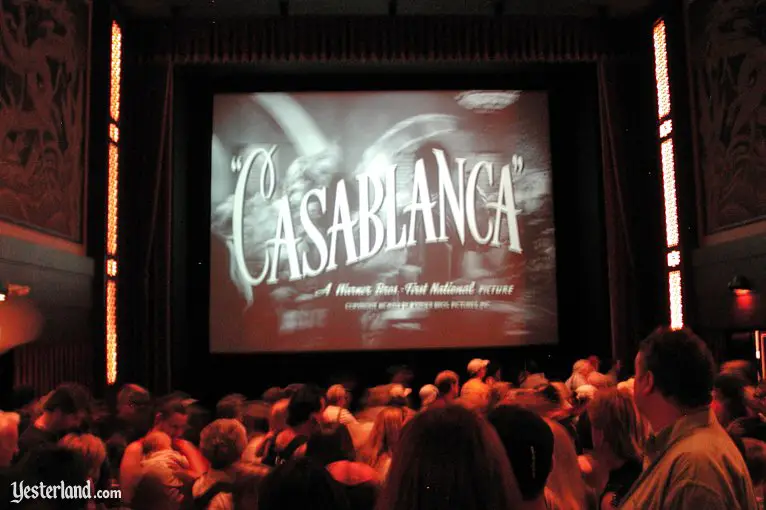
Casablanca trailer in the queue for The Great Movie Ride |
|||
|
The Los Angeles Times reported the same news in this item by John Voland on June 14, 1988—except the Voland pointed out that Disney only said it was “probably” the same plane: The original Lockheed Electra 12A airplane seen taking off at the end of the classic 1941 film Casablanca may have been discovered by props people at the Walt Disney Co. While gathering props for The Great Movie Ride attraction for its theme parks, the company began searching for a similar Lockheed Electra to be part of the final Casablanca scene in which stars Humphrey Bogart and Ingrid Bergman say goodby. But a Disney research team found a Lockheed Electra 12A, Serial No. 1204, in Hondo, Tex., and said it is probably the plane used in the Warner Bros. film. The main point of both reports—that Disney, while looking for a plane similar to the one in Casablanca, apparently stumbled on the very plane that climbed into the foggy night air on its way to Lisbon at the end of the movie—was amazing news. Maybe the news was too amazing to be true. |
|||
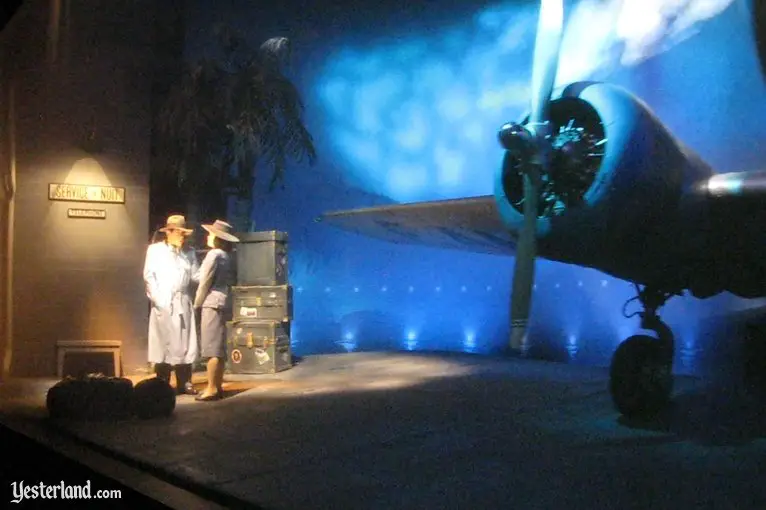
Casablanca in The Great Movie Ride, with Audio-Animatronic Rick and Ilsa |
|||
|
Disney-MGM Studios and The Great Movie Ride opened May 1, 1989. Cast Members proudly told guests that the park had the real plane from the movie. Then the story seemed to fall apart. In the early 1990s, 50 years after the release of Casablanca, several books appeared about its making. Readers learned that for the beloved airport scene at the end of the movie, the actors were on a soundstage at Warner Bros. in Burbank because of wartime restrictions, not on location at an airport. There was no real airplane on the soundstage, only mock-ups. The famous fog was there to obscure the fakery. |
|||
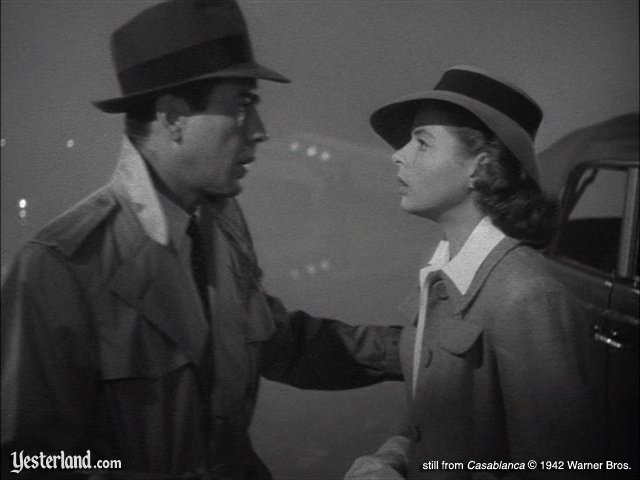
Real Humphrey Bogart; real Ingrid Bergman; fake airplane. |
|||
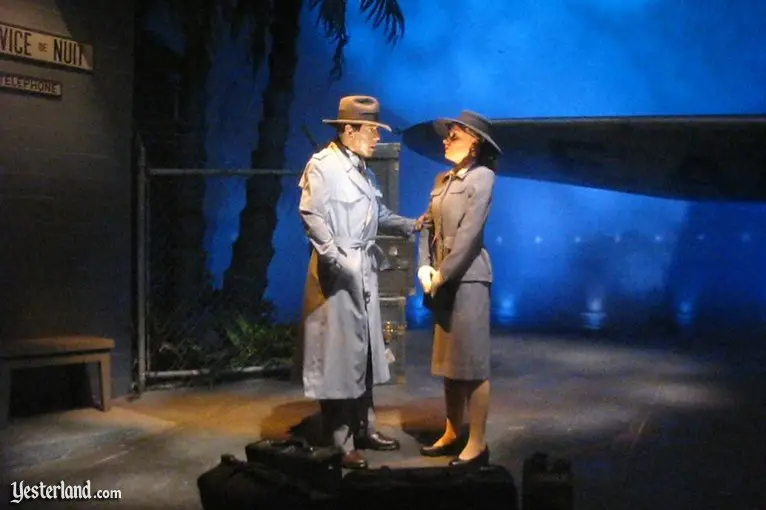
Fake Humphrey Bogart; fake Ingrid Bergman; real airplane. |
|||
|
The popular and respected “Snopes” Urban Legends website put it this way: “There was only one small problem with Disney’s serendipitous claim—no such airplane appeared in the film.” The Wikipedia entry about The Great Movie Ride also branded it as incorrect: “The ride vehicle then moves past the classic final scene from Casablanca featuring audio-animatronics of Humphrey Bogart and Ingrid Bergman as they stand in front of a waiting airplane. Some incorrectly claim that this plane, a Lockheed Model 12 Electra Junior, is the actual plane used during the filming of the movie, but it isn’t, as no full-size plane was actually used during the filming of Casablanca.” (This is the wording on Wikipedia on December 10, 2010.) Disney backed off from the claim, although many well-meaning Cast Members continued to tell the story. Recently, I popped a DVD of Casablanca into my computer to get closer look at the airport sequences. There are two. |
|||
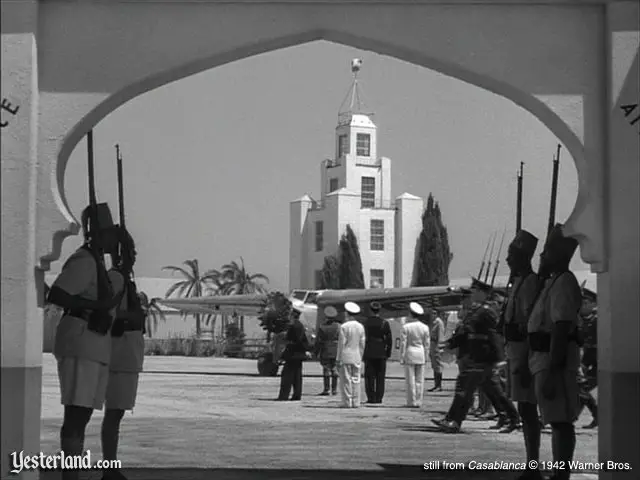
Location scene of Major Strasser arriving at the airport |
|||
|
In a daytime scene about five minutes into the movie, Major Strasser lands at Casablanca Aero-Gare. The airport is actually Los Angeles Metropolitan Airport, which is now called Van Nuys Airport. In one shot, an elaborate matte painting behind the airport replaces the San Fernando Valley with a Casablanca cityscape and the Atlantic coast. The sequence involves a model single-engine plane that appears to fly over Warner’s Casablanca set. Then a real swastika-emblazoned plane lands in front of the distinctive twin hangars of the airport. Major Strasser alights from the plane with Van Nuys Airport’s Art Deco radio tower (demolished in the 1960s) in the background and a movie prop arch in the foreground. |
|||

Not a real airport hangar; not a real airplane |
|||
|
In contrast, the actors never leave the soundstage for the nighttime airport shots at the end of the movie. It doesn’t matter. The story, casting, acting, dialog, staging, music and editing are so great that we only care about what’s happening, not about how it was done—unless you’re like me, and you’re watching the DVD frame by frame, looking at the details. |
|||
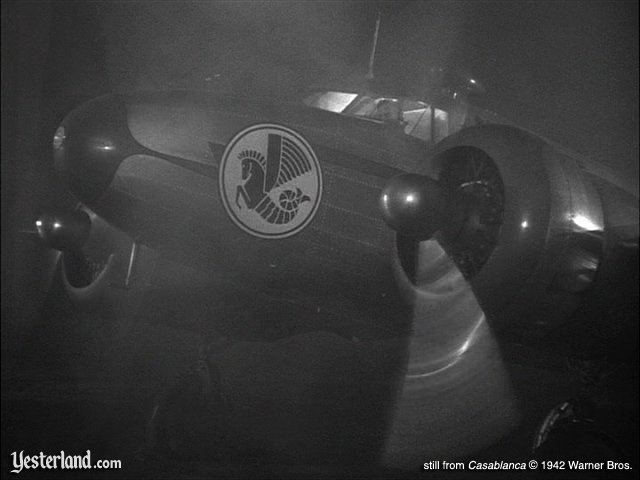
Real Lockheed Electra 12A starting its engines |
|||
|
Around four minutes before the end of the movie, there are two very quick aircraft engine shots, with dramatic noise from the mighty piston engines revving up and the propellers turning. One shows the starboard engine. The other shows the cockpit and the port engine. Mist is being sprayed into the scenes in both shots in an attempt to match the foggy look of the rest of ending. Skillful sound editing of the engine noise makes this footage blend well with the soundstage footage. The pilot is clearly visible moving around in the cockpit. An Air France winged hippokamp (water horse from Greek mythology) logo has been applied over the Lockheed lightning bolt stripe. It’s not a real Air France plane because Air France never operated this aircraft type. It looks absolutely like a real plane to me, and it just wouldn’t make sense to create a model this detailed, equipped with real, operational engines and propellers, for a couple of 1-second shots. Also, if the model were this perfect, there would be no need for the fog. But I tell myself that perhaps I am mistaken. |
|||
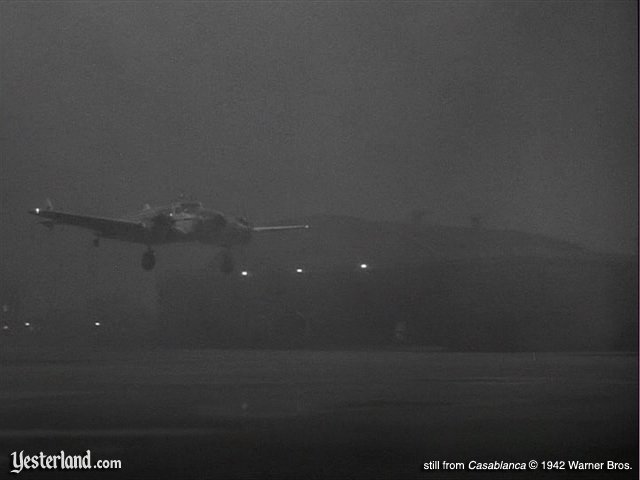
Real Lockheed Electra 12A taking off from Los Angeles Metropolitan Airport |
|||
|
Then, about one minute before the end of film, the plane takes off. The take-off consists of three separate shots. The first has no actors. The Lockheed Electra 12A is gaining altitude. It appears to be a real plane flying at a real airport. I go through the frames over and over. The plane behaves exactly like a real plane, with just the right amount of “wiggle.” It’s taking off in front of the distinctive twin hangars of Los Angeles Metropolitan (Van Nuys) Airport on the same runway where Major Strasser’s plane landed. It’s either a real plane taking off, or it’s an incredibly sophisticated special effects shot. |
|||
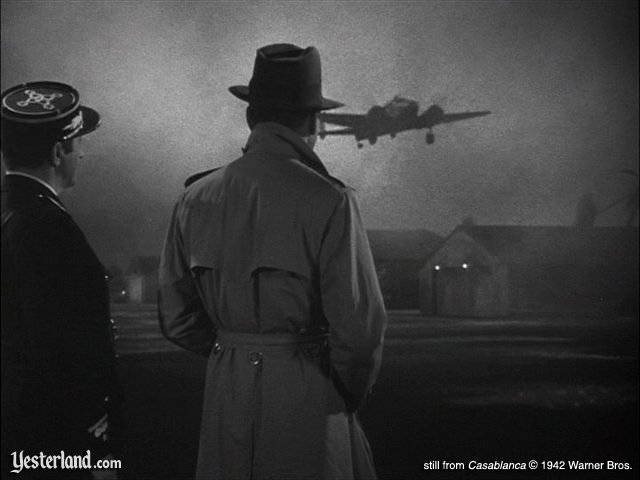
Cut to soundstage and fake take-off |
|||
|
Then there’s a cut to a shot of Capt. Renault (Claude Rains) and Rick Blaine (Humphrey Bogart) watching the take-off. Although the airplane is still moving at the same speed and angle, it’s now much less distinct; it appears to be a model or a cutout or an optical effect, and the background has changed to a backdrop painting that doesn’t match the background before the cut. I described what I saw to Disney historian Jim Korkis, author of The Vault of Walt, and discussed it with him: Werner Weiss: I’m now convinced that the ending of Casablanca includes a real Lockheed Model Electra 12A, which opens up the possibility that the plane in The Great Movie Ride was in the movie after all. Jim Korkis: Werner, you never cease to amaze me. When you told me, I pulled out my DVD copy of the film and all my books on the making of the movie. It is my favorite film of all time. Do you know why the last scene was shot on Stage 1 at Warner Brothers Studio? WW: Because of the war, right? JK: The assistant director on the film, Lee Katz, shared the explanation with writer Aljean Harmetz in his 1993 book Round Up the Usual Suspects: The Making Of Casablanca. Let me read it to you: “We were not allowed to leave the lot. So this airport was built on a stage with a cutout airplane. And, obviously, we fogged in the set not so much to give it atmosphere but because we had to conceal the fact that everything was so phony. We finally positioned the plane, which was, I thought, a pretty bad cutout, as far away as we dared. And we had no way to give it any perspective. And it occurred to me to hire a bunch of midgets to portray the mechanics. To give it a forced perspective. And it worked.” WW: A cutout airplane? JK: When Katz says it is a “cutout airplane” what he is referring to is not a two-dimensional plywood facade but that the Warner Bros. studio prop department created two models—one half-size and one quarter-size—out of balsa and plywood to use in the limited space of the soundstage. WW: Just because the dialog was all filmed on a soundstage doesn’t preclude using shots of a real plane for realism. JK: I think we all forget how amazing some of the model work was in the ’40s, whether it was a pirate ship floating on the water in a studio tank or whatever. However, I think the “smoking gun” for a real plane in that brief take-off is that outline of the Van Nuys Airport in the background and that it would be cheaper to use a real airplane propeller starting up rather than trying to re-create it as a model. I wonder if all of this is clearer in the Blu-ray version? By the next day, Jim had watched his DVD, and I had borrowed a high-definition Blu-ray disc of Casablanca from a local library and watched some scenes over and over. Werner Weiss: The Casablanca Blu-ray didn’t provide any major revelations. It just supported what I already saw on the DVD. The soundstage shots of the fake plane are even more obviously fake on the Blu-ray than on the DVD, but I have to say the editing is excellent. The closeups of the plane with the engines and propellers show a real plane. And on the take-off, it’s even more obvious that the first part is a real plane and the second part is a clumsy studio effect. Jim Korkis: Wow! This opens up a whole can of worms, doesn’t it? Obviously the plane in the attraction is definitely not in any of the scenes with the actual actors, but might have been in second unit insert shots... WW: And therefore in the movie! Those in the 1990s who claimed there was never a real Lockheed Electra 12A in the movie reached their conclusions before the era of DVDs and Blu-rays. A fuzzy VHS tape might not reveal the same details. Also, they may have relied too heavily on the accounts in a few books, without considering that filming actors on a soundstage wouldn’t eliminate the possibility of including a real plane too. JK: It is hard to argue with that possibility. No pun intended, but it is obviously not just black and white when it comes to this Disney story. WW: I think we’ve figured out that any claims that there was no real plane at the end of Casablanca are false. Now, the big question is whether the plane in the movie and the plane in the ride are the same one. What can you tell me about the plane is the ride? JK: The plane that appears in the Casablanca tableau in The Great Movie Ride is indeed a Lockheed Model Electra 12A, which was a small, six-passenger, twin-engine plane used in the late ’30s by small companies or private individuals. This one had a long and colorful career, including being used in some movies in the ’40s. When the Disney Company checked the serial number verifying that it had been registered to the film studio at the time, they assumed it could have been used in the film Casablanca and, in fact, announced in 1988 that it was indeed the same plane. WW: To me, it seems possible that it’s the same plane. But I’ve read that Lockheed built 130 Electra 12A aircraft. Do you think it’s the same one? JK: I know that when the revelation came out that no real plane was used in the scene that one Imagineer I know, who has always been a reliable source, told me that he was confused. He was part of the team that located the plane, and investigating the serial number did show it was at Warners around that time period. WW: So Warners apparently had a plane in 1942, but couldn’t use it with the actors. The usual reason given is that the soundstage wasn’t big enough. Even if it had been, it would probably not have been possible to move an airplane that size with permanently attached wings down city streets from an airport to Warner Bros. Studios. JK: Ironically, the Casablanca tableau in The Great Movie Ride has limited space as well, so the back half of the plane was chopped off and relocated at first to the Studio Backlot Tour and then eventually to the Jungle Cruise attraction at the Magic Kingdom, just before the hippo pool. |
|||
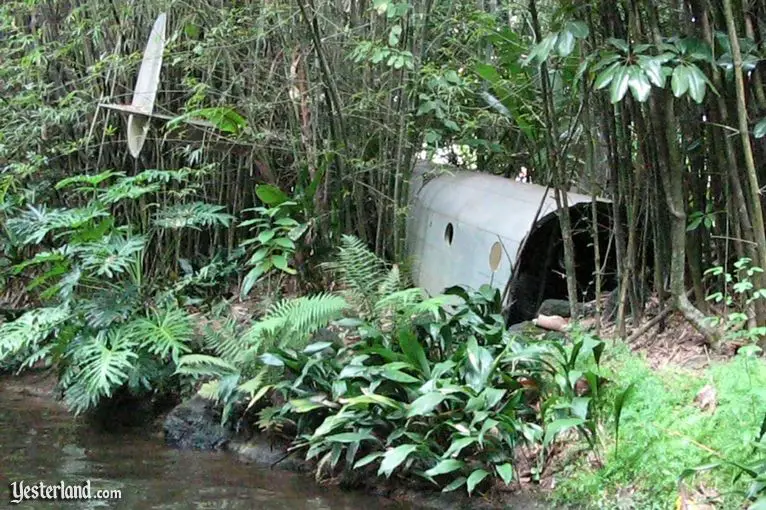
The back part of the airplane in the Jungle Cruise at the Magic Kingdom |
|||
|
After my exchange with Jim, I was still not sure I could make a convincing case that there was a real plane in the movie. Then I discovered another book. In Casablanca: Behind the Scenes (Simon and Schuster, 1992), author Harlan Lebo describes how the nighttime shots of the Electra 12A became part of the movie. Production manager Al Alleborn successfully obtained permission from the Fourth Interceptor Command, which governed the air space in the Los Angeles area. It was a remarkable achievement, considering near-nightly blackouts due to concern about the possibility of Japanese attacks. Michael Curtiz, the director of Casablanca, was able to send a second unit to what is now Van Nuys Airport, just as filming of the studio airport sequences was wrapping up. Here’s how Lebo describes it: The filming of the airport scenes on Stage 1—with on-set arguments, eleventh-hour arrivals of dialogue, and directorial script manipulations—marked a turning point in the production. The shooting had passed its toughest obstacles; as the most difficult filming was completed, the production rolled toward its conclusion. With sighs of relief all around, Curtiz wrapped up the last of the airport sequences on July 22—the most arduous five shooting days of the picture. The day before, the Curtiz Show passed its planned completion date; the production was by this time officially over schedule. The next day, a Warner second unit directed by Ross Lederman filmed the on-location night shots of the “Lisbon plane”—a two-engine Lockheed Electra—at the Los Angeles Metropolitan Airport. The night shooting had indeed been arranged; in the midst of world war, Alleborn’s influence with the Fourth Interceptor Command had prevailed. The busted “myth” has been unbusted. |
|||
|
|
|||
|
|||
|
You might be interested in these other Yesterland articles featuring discussions with Jim Korkis about Walt Disney World myths: Jim Korkis is the author of The Vault of Walt (2010): |
|||
© 2010-2012 Werner Weiss — Disclaimers, Copyright, and Trademarks Updated June 8, 2012.
Photo of The Great Movie Ride sign: 2007 by Werner Weiss. |
|||
